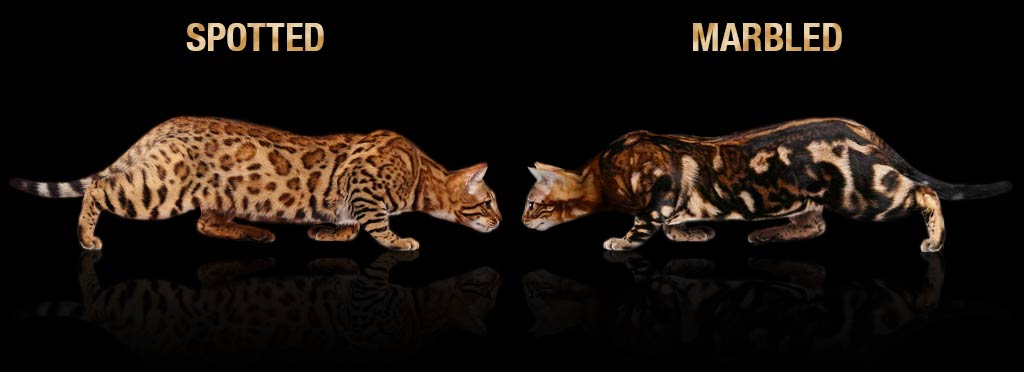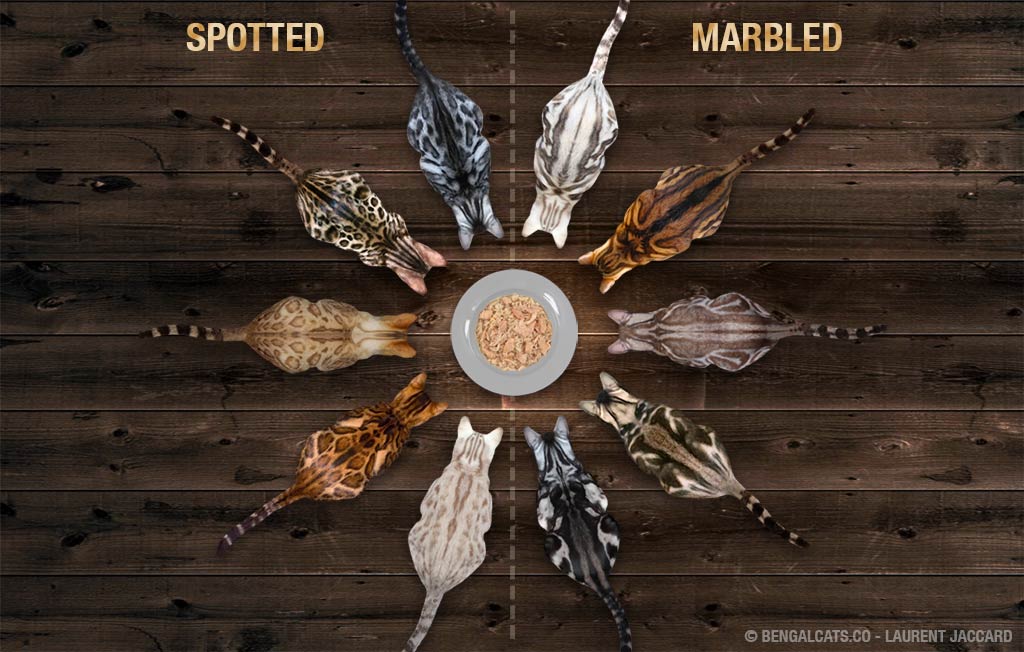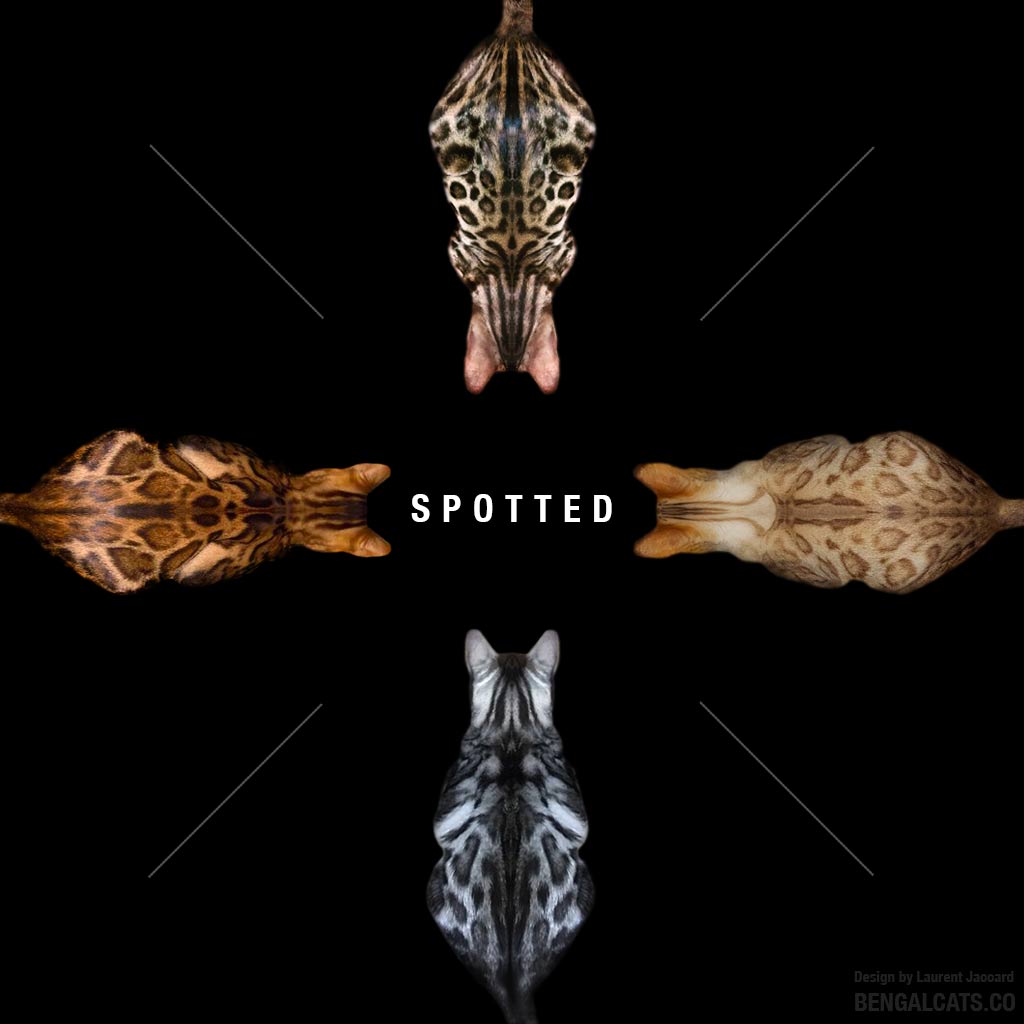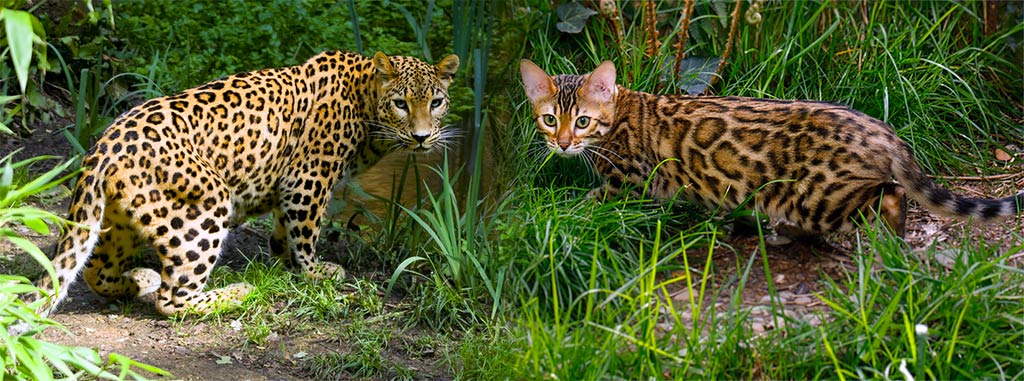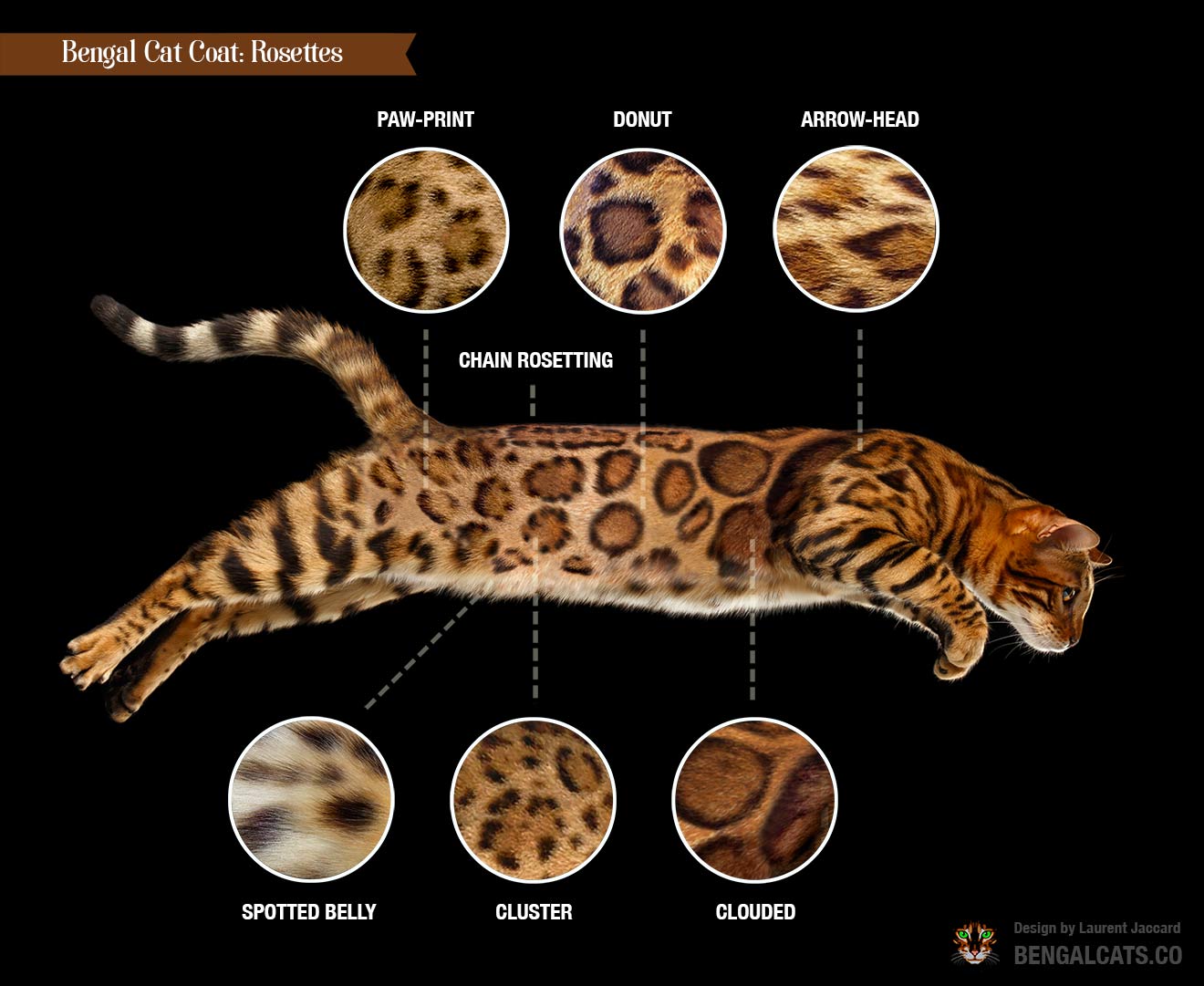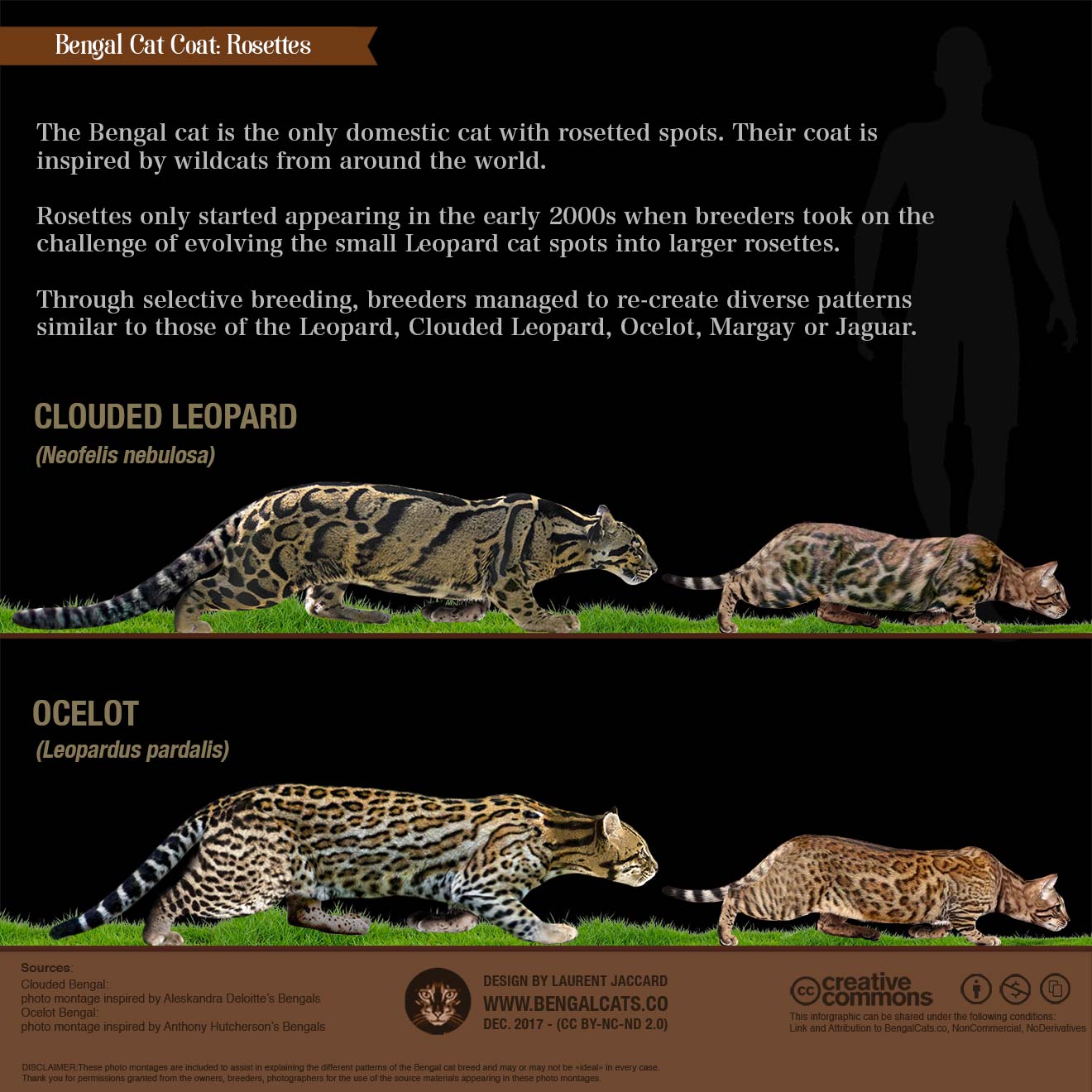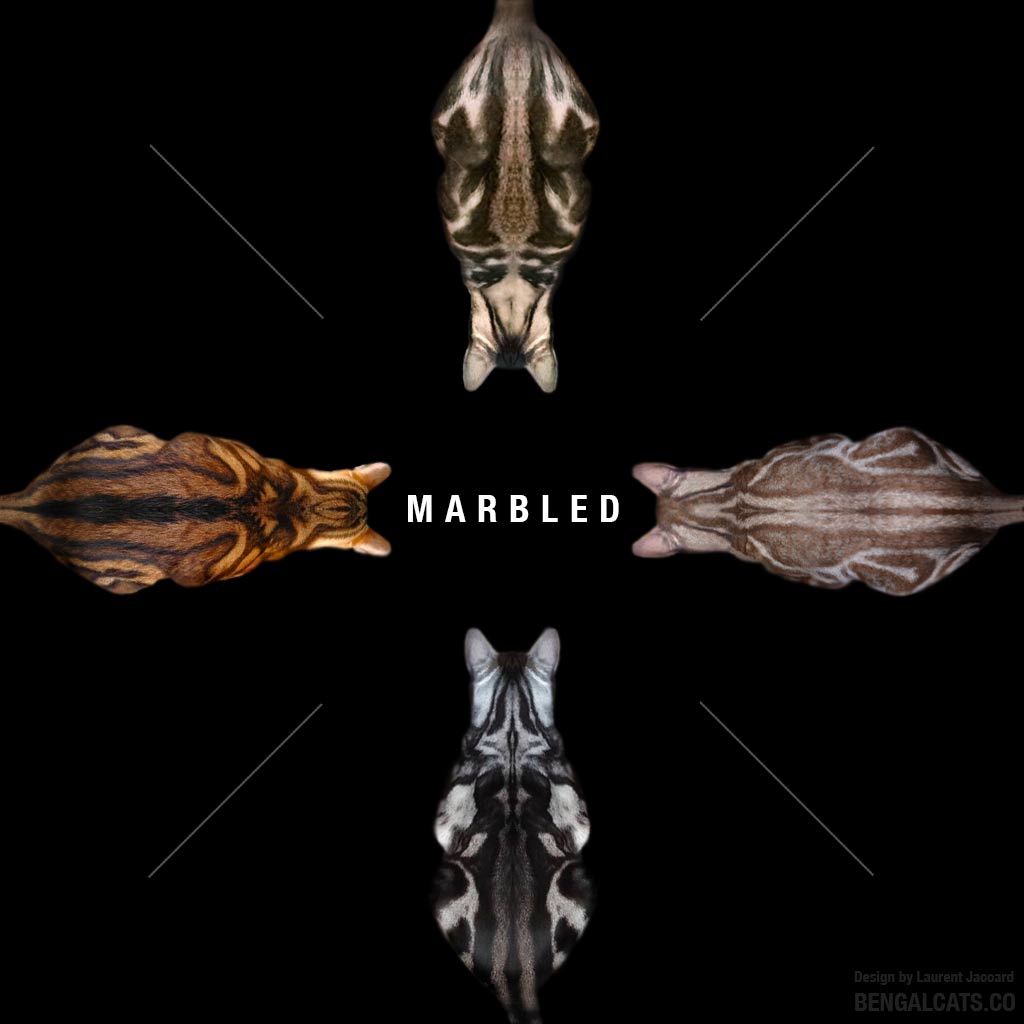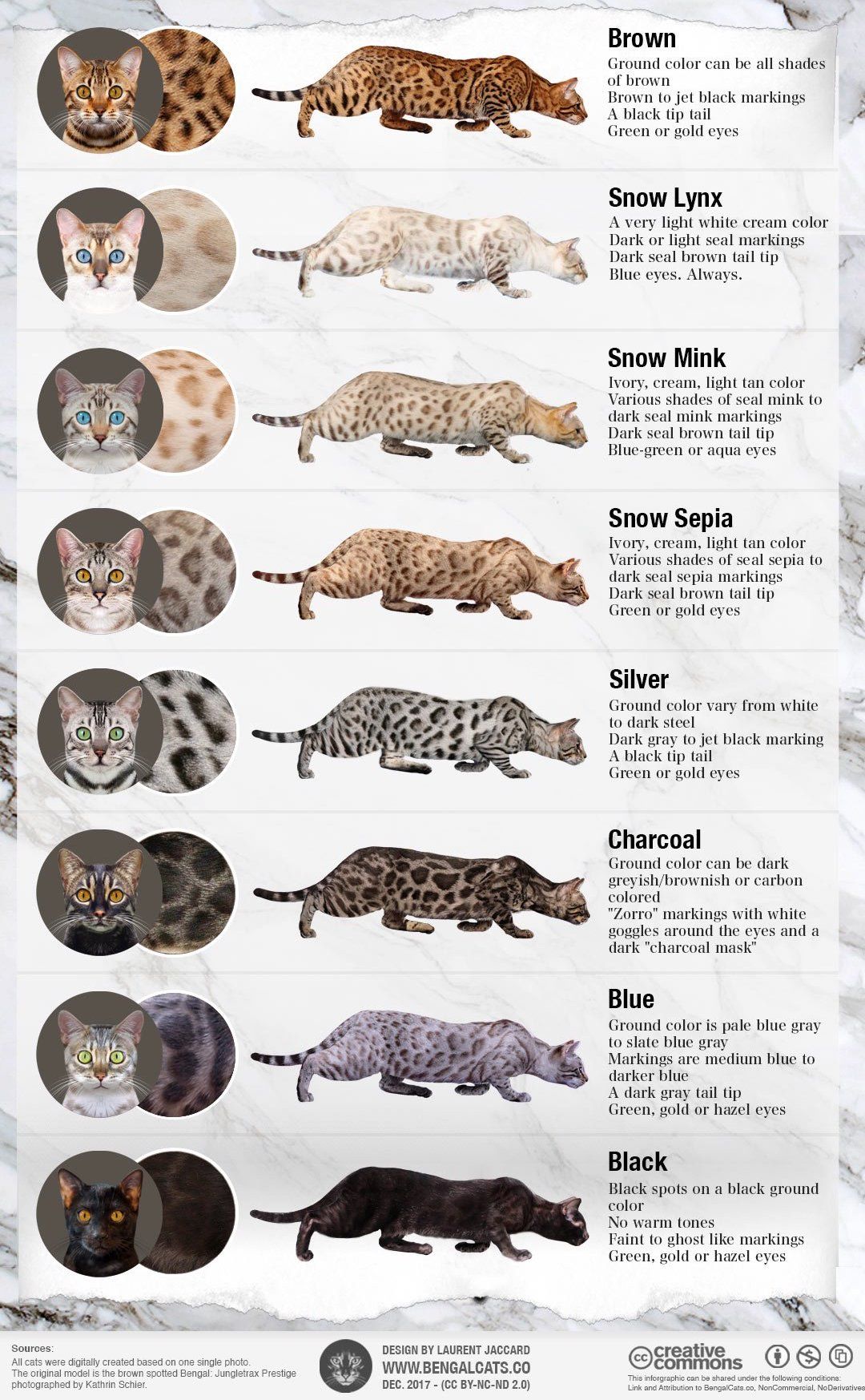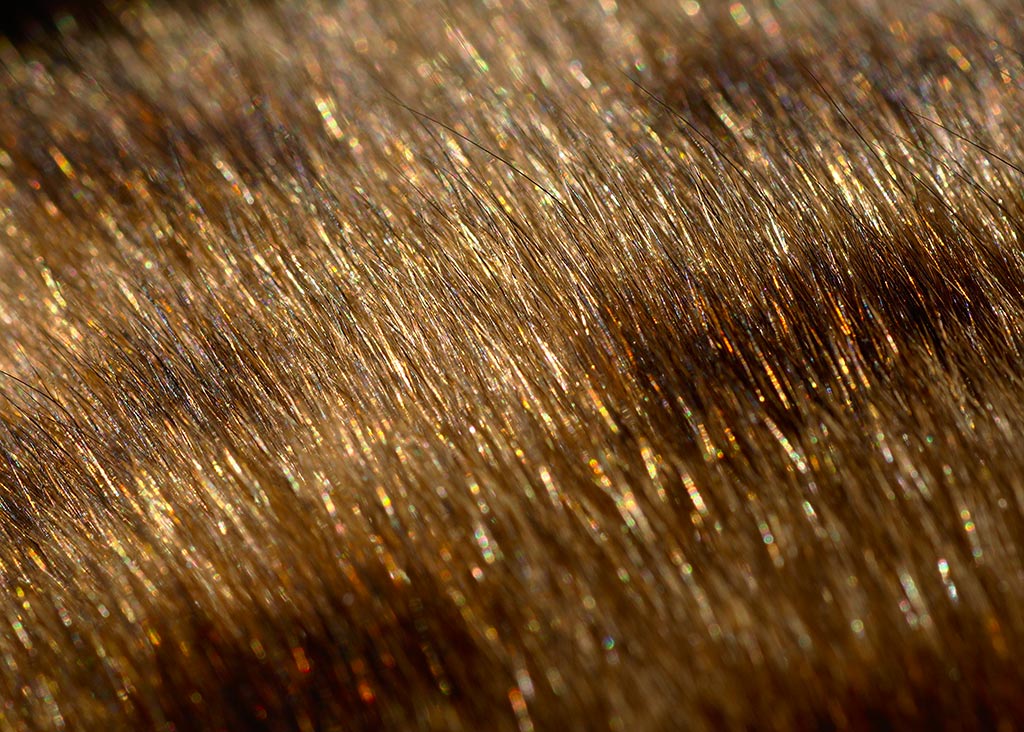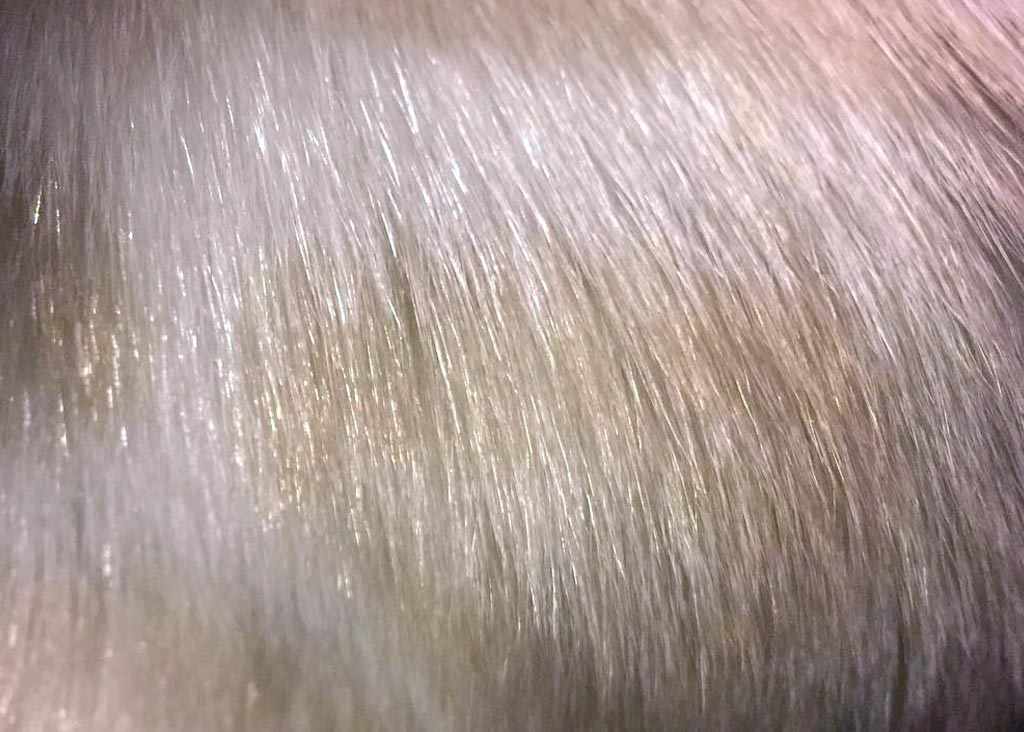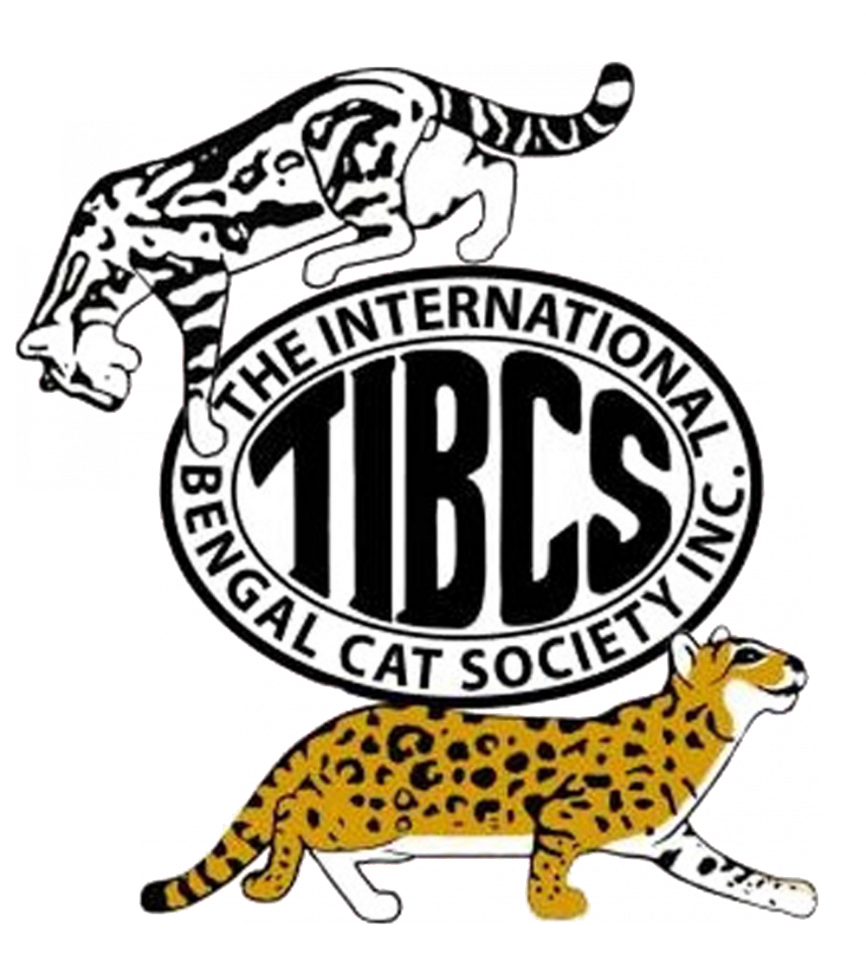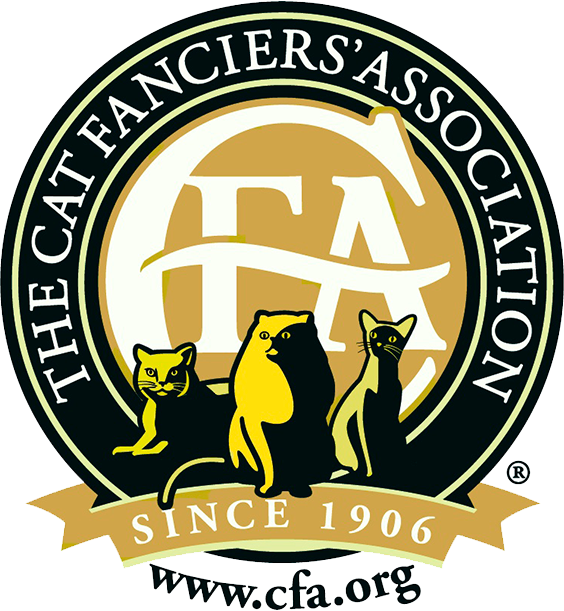Bengal cats are a dream come true. Not only are they beautiful, they are a domestic cat with a look that imitates the big cats found in the wild.
All domestic cats, pedigreed or not, come in a variety of colors and patterns. The popular spotted and golden leopard coats are not the only accepted color and pattern for Bengals.
Bengal cats are more than small, domestic versions of their larger cousins from the jungle. There is a wide range of colors, shades and patterns within the Bengal breed.
Depending on both parent’s genetic background, kittens within the same litter, can be very different from one another. Fortunately, the mapping of the feline genome allowed the genes that control coat, color and pattern in cats, to be studied and identified with DNA tests. Genetic testing allows breeders to predict the possible outcome of an upcoming litter and can prevent diseases to become an integral part of a breed.
Strictly speaking, there are only three basic breed-accepted colors: Brown, Silver and the three Snow colors (Seal Lynx, Seal Sepia and Seal Mink Point). Within each color category, there are two accepted types of pattern: Spotted and Marble.
With so many Bengal cat variations, you may not know where to begin when searching for your dream cat. That’s why we’ve put together this illustrated guide to Bengal cat colors.
With this guide, you’ll know exactly what you’re looking for when picking out your own dream kitty. Or, you’ll be able to identify the type your best friend just brought home.
Bengal Cat Patterns
Before we look at Bengal cat colors, the first thing you should know about Bengal cats is that there are 2 coat patterns:
- Spotted
- Marbled
But don’t let the 2 coat categories fool you: there are unique varieties of each type of pattern and a myriad of Bengal cat colors out there, which we’ll get to in a moment.
1. The Spotted Coat
A spotted coat Bengal cat is the most popular style of coat. Odds are, if you’ve seen a Bengal cat or are learning about what a Bengal cat even is, you’ve seen this cat in spotted form.
The brown spotted tabby was recognized for Championship status (TICA) in 1991.
The spotted Bengal has characteristic, small to medium sized spots all over their coats. Large, random, two-tone rosetted markings are particularly prized. AKA they’re the house cats that look like mini leopards.
This pattern style appeared when breeders believed that larger and sparser spots were more desirable. The original spotted tabby pattern found in domestic cats has been modified by selective breeding.
The coat is covered in random, diagonally or horizontally aligned spots on the torso, tummy and legs. Large dark spots on a light ground color is usually preferred.
Of course, there are variations to the spotted category and there can be many different types of spots on a single Bengal cat.
Single-Spotted
Single-Spotted means the spots are monochrome. It’s just solid spots splattered in droplets on a contrasting background, similar to those of wild cat like Cheetahs or non-hybrid spotted cats (Ocicat, Egyptian Mau, Spotted Shorthair or Australian Mist).
Single-spotted Bengals are allowed to compete in cat shows but they are not preferred. Some breeders think they should be ineligible for competition.
The most popular spotted coat for a Bengal cat is the “Rosetted Bengal“. Spots are called rosettes when the spots are two-toned contrasting colors distinct from the background color. The Bengal cat is the only domestic cat with rosetted spots!
Rosettes in Bengals only started appearing in the early 2000s when some breeders bred shadow spots to shadow spots. The rosette quickly developed.
When you see the evolution of the breed over the years, it is amazing to realize the progress that has been made by some breeders with rosetting in just a few decades.
The 3 most important types of rosettes are:
- Arrow-head
- Paw-print
- Donut
Arrowhead Rosettes
Arrowheads can be solid and monochrome in the single spotted group or they can be rosetted with different colors fading into the background. Well-defined arrowhead rosettes are rare and sought after by Bengal cat owners and breeders.
The arrowhead rosette is not the most common one but it is probably the easiest type of rosette to identify. Arrowhead rosettes are shaped in a triangular form similar to the tip of an arrow or a drop, with all tips pointing to the back of the cat.
Asian Leopard cats have many different types of coats but the arrowhead pattern is one of their most visually spectacular one. Arrowhead-shaped spots are a great camouflage in the dappled light of a forest habitat. With such a coat, a cat who stands very still in the trees or fallen leaves can be very hard to spot.
The Bengal cat breed standard calls for spots to be horizontally aligned instead of the classic tabby’s vertically aligned spots. The arrow-shaped spots on a cat’s coat give them a particularly fluid horizontal appearance and create a unique illusory motion.
Donut Rosettes
Donut rosettes are spots that are darker than the background’s coat color and outlined with an even darker color.
Inspired by the Jaguar’s coat, the donut rosette got its name from it’s nearly complete dark outline around a lighter colored center.
It took years of selective breeding to achieve doughnut-shaped rosettes but they are now one of the most popular rosette.
Some people also like to differentiate these rosettes according to the size of their outlining and overall size. Pancake rosettes describe huge rosetting and small outlining. Donut spots have a thicker outlining than pancakes.
Paw-print Rosettes
Paw-print rosettes are shaded spots open on one side with smaller and darker spots on the edge. A paw-print rosette is never entirely enclosed by the darker, surrounding color.
Inspired by the Leopard’s coat, paw-print rosettes earned their name as they often look like little paw prints walking across the cat’s coat.
Clouded Rosettes
Clouded rosettes are large, full rosettes that appear to fit together like a puzzle with little spacing (acreage) in between.
Inspired by the Clouded Leopard’s coat, this reticulated spotting has an almost snake-like appearance.
Chain Rosetting
Chain rosetting describes a connected row of donut rosettes linked together horizontally and running parallel on either side of the cat’s spine.
Chain-rosetting can also be seen on wildcats like Ocelots.
Cluster Rosettes
Cluster rosettes are small spots forming clusters around the center color.
So if you’re looking for a Jaguar, Leopard or Ocelot look, for example, you’re looking for the rosetted pattern.
2. The Marbled Coat
The marbled coat pattern is derived from blotched tabby stripes that swirl. The ideal marble Bengal cat has a horizontally flowing, random, asymmetrical pattern made up of swirls of two or more colors.
The marble Bengal cat has four official types—reduced horizontal flow, horizontal flow, chaos pattern, and sheet marble patterns.
In 1987, Jean Mill (Millwood cattery) produced the first Marbled bengal kitten in a cat named Millwood Painted Desert:
She was a spectacular little female with an odd soft, cream-colored coat and weird pattern that looked like drizzled caramel. At the Incats show in Madison Square Garden, and all over the country, she was a sensation!!
In her first standard for the Bengal breed, Jean Mill hadn’t intended to include anything except spots. But Painted Desert was an instant success with both judges and the public and thus the marbles were included in the Bengal registry.
The descendants from these early marbled Bengals contributed the outlining gene and horizontal flow which produced the first ‘rosetted’ spots in the 2000’s.
In 1993, the marbled Bengal was granted championship status within TICA.
Bonus: The Sparbled Coat
Did you think that spotted and marble patterns wouldn’t ever meet?
Enter the sparble pattern – where spots and marble collide. “Sparbling” isn’t really an official pattern category but in breeder lingo, it is used to describe Bengals who possess both rosettes and marble markings or spotted bengals with marble-ish patterns!
The sparble is considered a spotted/rosetted Bengal and not a marbled.
Bengal cats color
Now that we’ve looked at the types of coats Bengal cats have, let’s take a look at Bengal cat colors.
Like other breeds of cats, Bengals come in a variety of colors. There are about 6 Bengal cat colors, divided into standard and non-standard by The International Cat Association (TICA).
The standard Bengal colors are:
- Brown
- Snow
- Silver
Non-recognized colors are:
- Charcoal
- Blue
- Melanistic (Solid Black)
Yep, your standard cat colors. But of course, the complex beauty that is the Bengal cat isn’t just 6 color options. Nope – there’s so much more to Bengal cat colors. But, no matter what the color/tone, the pattern on a Bengal cat should yield a high degree of contrast.
The Brown Bengal cat
The brown Bengal cat (C,C color genes) is the most popular of the Bengal cat colors and it was also the first to be recognized by TICA in 1983.
The traditional brown colored Bengals have green or gold eyes.
The ground color can range from a gray-tawny tone to a vivid orange-gold.
The spotting, rosetting or marbling color can range from black, light brown to a darker or reddish brown.
If you have a brown furry friend, you probably know that brown come in a variety of shades like: Golden, Cream, Tawny, Honey, Taupe, Tan, Beige, Caramel, Cinnamon.
All shades of brown are accepted but an orange-brown is preferred for ground color.
As you can see, there’s virtually every shade of brown available for the Bengal breed.
Now, with a brown Bengal, you can find these characteristics:
- Brown to jet black markings
- A black tip tail
- Red nose
- Brown, copper, gold, green or hazel eyes
- A white belly is preferred
Gorgeous creatures, aren’t they?
The Snow Bengal cat
Looking for a mini snow leopard? Then this is the cat you’re looking for.
Bengals also come in a range of cream, ivory colors associated with a form of albinism that comes from Siamese and Burmese cats ancestry.
Contrary to what the name suggests, they are not pure white Bengal cats.
In fact, the snow Bengal comes in 3 genetically different colors (and names):
- Seal Lynx
- Seal Mink
- Seal Sepia
It can be tricky to tell the difference between the three seal colors. A genetic test is always the best method to differentiate the 3 snow Bengals. Alternatively, eye colors can help determine the snow Bengal color one has.
A Snow Seal Lynx Bengal (Cs, Cs color genes) has:
- A very light white cream color
- Dark or light seal markings
- Dark seal brown tail tip
- Blue eyes. Always.
A Snow Seal Mink Bengal (Cb,Cs color genes) has:
- Ivory, cream, light tan color
- Various shades of seal mink to dark seal mink markings
- Dark seal brown tail tip
- Blue-green or aqua eyes
A Snow Seal Sepia Bengal (Cb, Cb color genes) has:
- Ivory, cream, light tan color
- Various shades of seal sepia to dark seal sepia markings
- Dark seal brown tail tip
- Green or gold eyes
Not too bad, right? Shouldn’t be too hard to determine what color Bengal you’re after.
The Silver Bengal cat
Silver (I, i or I,I inhibitor genes) is more a lack of color. This gene inhibits any warm colors and gives an almost white base coat contrasted with striking dark markings.
The silver color was added to TICA championship in 2004 for the Bengal breed.
Silver Bengal cats come in different shades with backgrounds varying from white to a very dark steel color.
Silvers can also be found in any other color combination: Silver Snow, Silver Charcoal, Blue Silver, etc…
A silver Bengal also has:
- As little tarnish (yellow/rusty brown) in the coat as possible
- Dark gray to jet black markings
- A black tip tail
- A brick red nose
- Green or golden eyes
Should be easy to determine which cats are silver!
The Charcoal Bengal cat
A charcoal Bengal (Apb, a or Apb,Apb agouti genes) is darker than the traditional recognized Bengal colors. The black smoky charcoal color was particularly seen in early generation F1 and F2 Bengals.
The charcoal trait is inherited independently of color and can be seen in each color class: browns, silvers, snows (lynx charcoal, mink charcoal, sepia charcoal) and even in blues.
Charcoals have a dark greyish/brownish or carbon colored backgrounds with very little to no rufous (reddish-brown) and a very dark spotted or marbled pattern.
Charcoals can also have a darker face “mask” and thick dorsal stripe, commonly referred to as the “Zorro cape and mask”.
The mask resembles an upside-down “Y” or a peace sign without the circle around it.
These charcoal masks can be very dark and eventually match the color of the black to black body markings.
The tail is dark brown/black or grayish black with stripes and a black tip
Charcoal browns and charcoal silvers can have a black body with “ghost” markings. They can be confused with solid color bengals. A solid “pointed” cat will have solid color on the face. Solid black bengals are called “melanistics” and solid silvers are called “silver smoke”.
The Blue Bengal cat
The blue color (d,d dilute genes) is very rare but some breeders are working hard to try and promote the blue Bengal to championship status.
Blue Bengal cats have a powder blue/grey coat with some cream tones. The spotted or marbled pattern is a dark blue or metal grey color.
As it is a reccessive gene, both parents must carry for blue in order to produce a blue Bengal cat.
Blue Bengals also have:
- A steely blue ground color
- Peachy undertones
- Blue markings that will never turn black
- A dark gray tail tip
- Gold, green or hazel eyes
The Black (Melanistic) Bengal cat
Solid black Bengals (a,a agouti genes) have black patterns on a black ground color that remind us of the melanistic color variant of leopards and jaguars: the black panther.
The colors of the background and the pattern are the same on a melanistic Bengal. Their patterns are called “ghost markings” or “ghost spots” because they are barely visible. But you can still see the pattern in daylight like you would on a black panther.
Black colored Bengals are rare and less popular amongst breeders because this color variation is not approved by the associations.
As for the spots, they can be faint dark brown to black and can sometimes only be seen in natural sunlight.
A smoke Bengal is the silver variation of a melanistic.
If you’re looking for a mini black panther, this color of Bengal would be your best bet!
Patina and Ticking
Patina and ticking are two characteristics a Bengal cat can have that are slightly different from one another.
Patina is black or dark tipped hairs that blur the pattern of your cat. This blurring will show up from the shoulders all the way down the back of the cat.
Ticking, on the other hand, is where all of the fur on your cat looks blurry due to lack of contrast in the fur. This is caused by multi-colored hair shafts giving the fur a sort of “faded” look.
Essentially, the fur isn’t as bold on these cats.
Glitter
Glitter is your golden ticket – literally.
While Bengals are the first domestic cat to have glitter, not all Bengals have it.
You can see the glitter by the shimmering, sparkling effect on your cat’s coat. Even in low lighting, you’ll be able to see the sheen of the glitter on the Bengal.
Glitter on a Snow Bengal cat’s coat
But what is glitter, exactly?
No, Tinkerbell didn’t come by and pour some all over your cat.
“Glitter” is a translucent hollow hair shaft that catches the light and reflects it. It is present throughout the fur of your cat.
It’s truly a beautiful and remarkable sight. Who knew cats could be even more magical?
All information has been taken from https://www.bengalcats.co/


